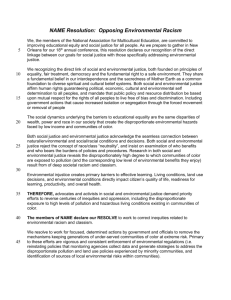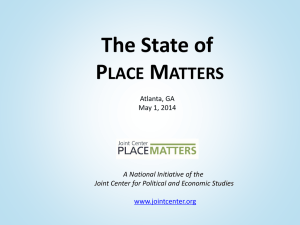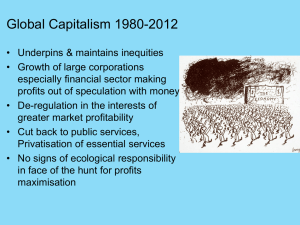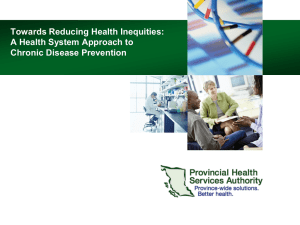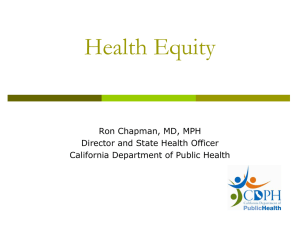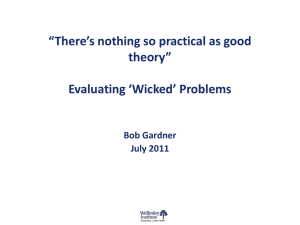social inequities - Alameda County Public Health Department
advertisement
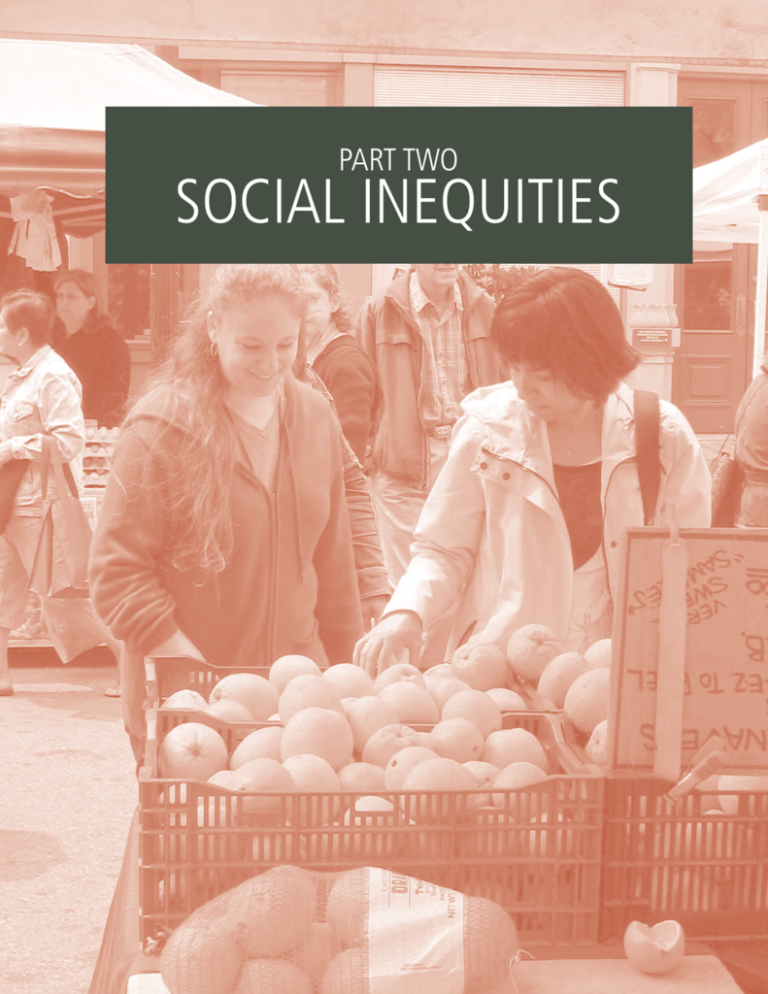
PART TWO SOCIAL INEQUITIES Social Inequities: Root Causes of Health Inequities A Worker’s Speech to a Doctor When we come to you Our rags are torn off us And you listen all over our naked body. As to the cause of our illness One glance at our rags would Tell you more. It is the same cause that wears out Our bodies and our clothes. The pain in our shoulder comes You say, from the damp; and this is also the reason For the stain on the wall of our flat. So tell us: Where does the damp come from? —Bertolt Brecht Understanding the Pathways From Social Inequities to Health Inequities S ocial inequities are disparities in power and wealth, often accompanied by discrimination, social exclusion, poverty and low wages, lack of affordable housing, exposure to hazards and community social decay. In the framework developed by the Bay Area Regional Health Inequities Initiative (BARHII) shown on page 26, social inequities are represented in a broad sense on the left, ‘upstream’ side of Figure 10 and labeled SoSocial Inequities cial Factors. The right side shows the more immediate medical causes of death, diseases and risk behaviors, which BARHII describes as ‘downstream.’ Most of this report focuses on the social causes—those that are considered the root causes of health inequities. While these factors are resistant to change because they form the very structure of society, they can be changed through intentional public and private policies with equity as the goal. LIFE AND DEATH FROM UNNATURAL CAUSES 25 Figure 10: Framework for Health Equity Socio-Ecological Model Discriminatory Beliefs (ISMS) ••Race ••Class ••Gender ••Immigration status ••National origin ••Sexual orientation ••Disability Institutional Power ••Corporations ••Businesses ••Government agencies ••Schools Social Inequities ••Neighbohood conditions - Social - Physical ••Residential segregation ••Workplace conditions Social Factors Adapted from the Bay Area Regional Health Inequities Initiative With social equity, resources and opportunities are shared more widely. When groups that have traditionally been excluded from decision-making are able to participate in problem-solving and exercise their power in order to leverage resources from powerful institutions, they are more likely to see positive changes to their household and neighborhood conditions. Such changes can, in turn, affect the health of these groups. Epidemiologist Nancy Krieger explains how unequal social and neighborhood conditions work through biological factors to determine the distribution of health: “While how we bring the world into us depends in part on our biological constitution (…exposure, development, growth, and gene expression), what we bring in is historically and socially contingent. Otherwise, there would be no variation in population health across time, place, and social groups.”1 Krieger identifies five ways this process occurs. 26 LIFE AND DEATH FROM UNNATURAL CAUSES Disease and Injury ••Infectious disease ••Chronic disease ••Injury Risk Behaviors ••Smoking ••Nutrition ••Physical activity ••Violence Access to Health Care Upstream Genetics Individual Health Knowledge Medical Model Downstream Mortality ••Infant mortality ••Life expectancy Health Status 1. Economic and social deprivation, including lack of access to adequate food, housing, and physical and social recreation. 2. Toxic substances, pathogens and hazardous conditions, at work, in the neighborhood, and more generally. 3. Social trauma, including institutional and interpersonal discrimination and violence, plus additional psychosocial stressors. 4. Targeted marketing of commodities that can harm health, e.g. junk food and psychoactive substances (alcohol, tobacco, and other licit and illicit drugs). 5. Inadequate or degrading medical care.1 These five pathways are evident in the specific social inequalities addressed in Part Two of this report: 1) segregation; 2) income and employment; 3) education; 4) housing; 5) transportation; 6) air quality; 7) food access and liquor stores; 8) physical activity and neighSocial Inequities borhood conditions; 9) criminal justice; 10) access to health care; and 11) social relationships and community capacity. This overview describes these inequities and how they work together to cause health inequities. History and Legacy Create and Sustain Social Inequities Historical factors must be taken into account in order to understand today’s social inequalities, concentra- tions of institutional power, and hazardous neighborhood conditions. In the case of American society, the history of racism, slavery, and oppression and the legacy these original scars left in the form of overt or unintended biased policies, must be acknowledged and addressed. The important concept of structural racism, explained in the accompanying box, is helpful for reaching this understanding.2 What Is Structural Racism and How Do We Play a Part in Eliminating It? Many organizations are currently engaged in researching the impacts of structural racism and working to mediate its effects and eliminate the policies that perpetuate it. The selected definitions and examples provide a brief explanation of what structural or institutional racism is and how it impacts many of the factors discussed in this report. “Racism in twenty-first century America is harder to see than its previous incarnations because the most overt and legally sanctioned forms of racial discrimination have been eliminated. Nonetheless, subtler racialized patterns permeate the political, economic, and socio-cultural structures of America in ways that generate differences in well-being between people of color and whites. Structural racism, then, refers to the system in which public policies, institutional practices, cultural representations, and other norms work in various, often reinforcing ways to perpetuate racial group inequity in every key opportunity area, from health, to education, to employment, to income and wealth.”11 For example, “a government agency decides that low-income housing must be built, which will house lowincome African Americans and Latinos. It fails to look for locations near jobs and important infrastructure, like working schools, decent public transportation and other services. In fact, it is built in a poor, mostly African American and Latino part of town. When the housing is built, the school district, already underfunded, has new residents too poor to contribute to its tax base. The local government spends its limited resources on transportation to connect largely White, well-to-do suburban commuters to their downtown jobs. The public housing residents are left isolated, in under-funded schools, with no transportation to job centers. Whole communities of people of color lose opportunities for a good education, quality housing, living wage jobs, services and support-systems.”12 “The structural arrangements produced by the walling off of resources and opportunities produces the racial disparities we see today—like higher poverty rates, greater infant deaths and lower high school graduation rates in communities of color. Racial disparities are the symptoms of our collective illness—structural racism. Whether it’s education reform, the environment, the workplace, urban planning and development, affordable housing or health care, we must make the role of race visible and understand the structures our institutions construct so that we may rebuild them to create opportunities for us all.”12 Social Inequities LIFE AND DEATH FROM UNNATURAL CAUSES 27 Economic and Social Resources Shape Health from Before Birth and Onward The resources we gain through education, income, and the type of jobs we hold determine our health, our children’s health, and the likelihood of being healthy in the future. As summarized in a recent MacArthur Foundation Research Network report,3 poor pregnant women tend to get less timely prenatal care, experience more stress, and deliver more premature and low weight babies than women with higher incomes. For their children, this inequity results in increased risk of infant death, slower cognitive development, hyperactivity, breathing problems, overweight, and heart disease. The longer people remain in poor social environments, the worse their physical and mental functioning will be later in life.4,5 Low-income children who are denied quality early education and preschool experiences are more likely to struggle socially and academically in the first years of primary school. These same children are those who are more likely to perform poorly on reading and math tests by the middle school years and to drop out in high school.6-8 Those who lack a high school degree are more likely to be unemployed, to be limited to working low-wage jobs, and to be unable to overcome conditions of poverty. Long‑Term Health Impacts of Inequities in Neighborhood Conditions Many health problems emerge from childhood. Some health inequities, therefore, are explained by different exposures of children living in poor neighborhoods relative to children higher on the social ladder. Poor children are more likely to experience lead, air and noise pollution, unstable housing that disrupts school attendance and social ties, fast food consumption that contributes to obesity, and violence in school and on the street that causes chronic anxiety.9 Poor children experience less timely health and dental care and less access to libraries, playgrounds and other safe places for play, physical activity, and socializing.10 Children’s 28 LIFE AND DEATH FROM UNNATURAL CAUSES exposure to such hazards is not a matter of parental choice, but partly a function of community design— design that can be altered through shifts in public policy. Over the last decade, researchers have taken great interest in studying the relationship between the built environment (the way neighborhoods are designed and maintained) and residents’ physical condition. Results indicate that neighborhood conditions affect the quality of the air we breathe, the kind of goods and services (either health-promoting or health-negating) we can access, and the extent to which we exercise, play outdoors, and connect socially with others. Land use decisions affect air quality. Air quality can be compromised by the placement of pollution-releasing facilities (such as diesel bus depots or hazardous waste sites) in communities as well as low-density development that increases reliance upon automobiles—a leading source of air pollution.13 Studies have shown that the communities most affected by environmental pollution (air,14 water,15 and noise16,17) are low-income, low-education, and high-minority. For example, rates of premature death are higher in environments with excesses of small particulate matter, or diesel pollution. Where an individual lives and what modes of transport he or she has access to determine the quantity and quality of retail goods and services available as well as opportunities for physical exercise.18 Living in an environment where there is a lack of healthy foods yet a high concentration of “unhealthy” goods and services, such as liquor stores and fast food restaurants, shapes health behaviors and perceptions about the neighborhood. With regards to opportunities for physical exercise, neighborhoods designed with stores, theaters, and other destinations within walking distance of home and work have the potential to promote physical activity. Neighborhoods that have parks, multiuse trails, and appealing sidewalks or public spaces for walking may also promote active recreation.19 Physical environments designed to facilitate commuting to Social Inequities work or school by foot, bicycle, or public transit help promote physical activity by incorporating walking or biking into people’s daily routine.18,20 Through planning code regulations and ordinances, local governments across the country have attempted to control the prevalence of unhealthy goods and services in their communities and to remove barriers to physical activity.21 Few, however, have fully integrated planning and public health in land use decisions. Interventions through land use represent some of the most effective and immediate policies that local governments can take to improve community health. Community-Level Leadership Needed for Structural Change The multiple hazardous neighborhood conditions and the lack of social and economic resources experienced by the very poor contribute to breakdowns in neighborhood social cohesion and diminished individual and community power to make change. The people who are most affected by poverty, run-down and toxic neighborhoods and limited community resources are rarely at the table when decisions are made. What will it take to change the social and built environments when they are so embedded in powerful economic and social structures? One approach that is being adopted as a health strategy by increasing numbers of communities is community capacity building. Initiatives focused on community-level leadershsip, exercise of community power, and increasing community capacity are strategies that have been shown to make a difference in poor neighborhoods.22-25 A respected health scholar, Nina Wallerstein, describes empowerment as “a social action process that promotes participation of people, organizations, and communities toward the goals of increased community control, political efficacy, improved quality of life and social justice.”26 Such social action processes exist in Alameda County and can serve as case studies for learning and replicating. Engaged, empowered community groups Social Inequities can leverage resources to address neighborhood problems.27,28 Professionals—whether planners, academics, elected officials, government, or private bureaucrats—wield considerable social and political power relative to poor residents. By partnering and yielding power to community groups and their leaders, institutions can create a social context that encourages connection, respect and productive problem solving and decision-making. Such partnerships can inspire more community participation and especially gain momentum if they are organized on the basis of place.29-32 A local example of such placed-based positive partnerships is the City-County Neighborhood Initiative (CCNI). The Alameda County Public Health Department has partnered with the City of Oakland and community groups, using the following strategies to build community capacity and achieve residents’ priorities for action. zz Developing local leaders. zz Establishing resident action councils. zz zz zz zz Supporting community initiatives through minigrants. Promoting positive youth development. Rebuilding the community social fabric through the Sobrante Park Time Bank. Promoting healthy lifestyles. The specific activitiees related to these strategies are described in the last section of Part Two, Social Relationships and Community Capacity. Looking back the Framework for Health Equity (Figure 10 on page 26), empowering residents and building community capacity can be seen as an intervention between “Institutional Power” and “Neighborhood Conditions.” The assumption is that communities with skilled leaders and empowered advocates who partner LIFE AND DEATH FROM UNNATURAL CAUSES 29 with existing local institutions in on-going decisionmaking will be able to influence policy priorities and leverage funding in order to improve the environments in which they live. 30 LIFE AND DEATH FROM UNNATURAL CAUSES Social Inequities References 1. Krieger N. Introduction: Embodiment, Inequality, and Epidemiology: What Are the Connections? In: Krieger N, ed., Embodying Inequality: Epidemiologic Perspectives. Amityville, New York: Baywood Publishing Company. 2005: 2-3. 2. Center for Social Inclusion. Structural Racism. Available at: http://www.centerforsocialinclusion.org./struct_racism.html. Accessed April 2008. 3. Adler NE, Stewart J, et al. Reaching for a Healthier Life: Facts on Socioeconomic Status and Health in the U.S. The John D. and Catherine T. MacArthur Foundation Research Network on Socioeconomic Status and Health, 2007. 4. Galobardes B, Lynch JW, and Davey-Smith G. Childhood Socioeconomics Circumstances and Cause-Specific Mortality in Adulthood: Systematic Review and Interpretation. Epidemiologic Reviews. 2004;26: 7-21. 5. Case A, and Paxson C. The Lasting Impact of Childhood Health and Circumstance. Journal of Health Economics. 2005:24(2): 365-389. 6. Willms JK. Quality and Inequality in Children’s Literacy: The Effects of Families, Schools, and Communities. In: Keating DP, and Hertzman C, eds. Developmental Health and the Wealth of Nations: Social, Biological, and Educational Dynamics. New York: The Guilford Press. 1999: 72-93. 7. Brooks-Gunn J, Duncan GJ, and Britto PR. Are Socioeconomic Gradients for Children Similar to Those for Adults?: Achievement and Health of Children in the United States. In: Keating DP, and Hertzman C, eds. Developmental Health and the Wealth of Nations: Social, Biological, and Educational Dynamics. New York: The Guilford Press. 1999: 94-124. 8. Case R, Griffin S, and Kelly WM. Socioeconomic Gradients in Mathematical Ability and their Responsiveness to Intervention during Early Childhood. In: Keating DP, and Hertzman C, eds. Developmental Health and the Wealth of Nations: Social, Biological, and Educational Dynamics. New York: The Guilford Press. 1999: 125-149. 9. Adler NE, Stewart J, et al. Reaching for a Healthier Life: Facts on Socioeconomic Status and Health in the U.S. The John D. and Catherine T. MacArthur Foundation Research Network on Socioeconomic Status and Health. 2007. 10. Case A, Lubotsky D, and Paxson C. Economic Status and Health in Childhood: The Origins of the Gradient. American Economic Review. 2002;92:1308-1334. 11. Lawrence K, Sutton S, Kubisch A, Susi G, and Fulbright-Anderson K. Structural Racism and Community Building. Aspen Institute Roundtable on Community Change. Washington, D.C.: The Aspen Institute. 2004. 12. Center for Social Inclusion. Structural Racism: Definition. Available at:: http://www.centerforsocialinclusion.org./struct_ racism.html. Accessed April 2008. 13. Frumkin H. Urban Sprawl and Public Health. Public Health Reports. 2002;117(3): 201-217. 14. Brooks N, and Sethi R. The Distribution of Pollution: Community Characteristics and Exposure to Air Toxics. Journal of Environmental Economics and Management. 1997;32(2): 233-250. 15. Calderon RL. Health Risks from Contaminated Water: Do Class and Race Matter? Toxicology and Industrial Health. 1993;9(5): 879-900. 16. U.S. Environmental Protection Agency. The Urban Noise Survey. EPA 550/9-77-100. 1997. 17. Stansfeld SA. Noise Pollution: Non-Auditory Effects on Health. British Medical Bulletin. 2003;68: 243-257. 18. Wrigley N. Food Deserts in British Cities: Policy Context and Research Priorities. Urban Studies. 2002;39(11): 2029. 19. Frumkin H, Frank L, and Jackson R. Urban Sprawl and Public Health: Designing, Planning, and Building for Healthy Communities. Washington, DC: Island Press. 2004. 20. Frank LD, Engelke PO, and Schmid TL. Physical Activity and Public Health. In: Frank LD, Engelke PO, and Schmid TL, eds. Health and Community Design: Impact of the Built Environment on Physical Activity. Washington, DC: Island Press. 2003. 21. Ashe M. Land Use Planning and the Control of Alcohol, Tobacco, Firearms, and Fast Food Restaurants. American Journal of Public Health. 2003;93(9): 1404-1408. 22. Minkler M. Community Organizing and Community Building for Health. New Brunswick: Rutgers University Press. 1997. 23. Eng A, and Parker E. Measuring Community Competence in the Mississippi Delta: The Interface between Program Evaluation and Empowerment. Health Education Quarterly. 1994: 199-220 Social Inequities LIFE AND DEATH FROM UNNATURAL CAUSES 31 24. Wallerstein N, and Sanchez-Merki V. Freirian Praxis in Health Education Research: Results from an Adolescent Prevention Program. Health Education Research. 1994:9: 105-118. 25. Israel BA. Social Networks and Social Support: Implications for Natural Helper and Community Level Interventions. Health Education Quarterly. 1985;12: 65-80 26. Wallerstein N. Powerlessness, Empowerment and Health: Implications for Health Promotion Programs. American Journal of Health Promotion. 1992;6: 197-205. 27. Zimmerman MA, and Rappaport J. Citizen Participation, Perceived Control and Psychological Empowerment. American Journal of Community Psychology. 1988:16: 725-750. 28. Scultz AJ, Israel BA, Becker AB, and Hollis RM. It’s a 24-Hour Thing…A Living-For-Each-Other Concept: Identity, Networks, and Community in an Urban Village Health Worker Project. Health Education and Behavior. 1997;24: 465-480. 29. Hawe P. Making Sense of Context-Level Influences on Health. Health Education Research. 1998;13(6): i-iv. 30. Dovey K, Downton P, and Missingham G. An Ecology of Place and Place-Making: Structures, Processes, Knots of Meaning. Melbourne: Royal Melbourne Institute of Technology. 1985. 31. Curtis S, and Rees Jones I. Is There a Place for Geography in the Analysis of Health Inequality? In: Bartley M, Blanc D and Davey-Smith G, eds. The Sociology of Health Inequalities. Oxford: Blackwell Educational. 1998. 32. Kearns RA, and Gesler WM. Putting Health into Place: Landscape, Identity and Well Being. New York: Syracuse University Press. 1998. 32 LIFE AND DEATH FROM UNNATURAL CAUSES Social Inequities
